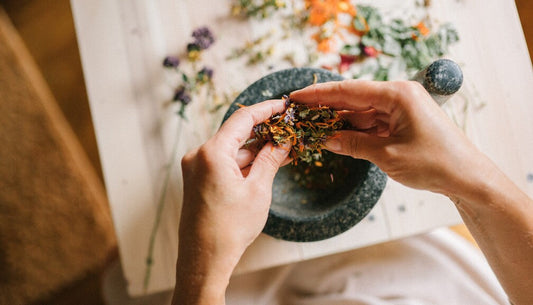Finding balance and happiness are lifelong processes. The ancient medical system of Ayurveda can provide guidance and tips along the way, especially as the season changes.
According to Ayurvedic wisdom, as the days get shorter and darker, transitioning from Summer to Autumn, we’re moving out of pitta season and experience vata elements. In Ayurveda: The Science of Self-Healing Dr. Vasant Lad says vata is “light, subtle, dry, mobile, rough, and cold. So, in the fall season, which also exhibits these attributes, vata will tend to be aggravated in the human constitution.”
You may experience a bit of a frenzied feeling or a general desire to slow down. You may crave time in nature and warm foods, and there are potential built-up disturbances from your summertime lifestyle.
Ayurveda reminds you that like increases like and that opposites facilitate balance: this is why you rarely crave spicy foods on a hot, summer beach day and why warm soup on a cold day is so nourishing. Take a holistic approach to wellness and trust yourself and your body this season. What would taste good? What would nourish you? As bikinis and sunsets give way to pumpkin spice and cozy nights, here are some ideas for finding harmony and inspiration.
Allow this season to be one of intention and balance, rather than anxiety and stress. Just as the leaves begin to fall from the trees, you too can shake off unnecessary worries and duties. Give yourself permission to lay low, stay in, or finally take action. Here’s to the season of chai tea, squash soup, and cinnamon spice.
Discover how to bring the ancient wisdom of Ayurveda into your daily life to stay healthy all year round with our introductory online course, Discovering Ayurveda. Learn More.
According to Ayurvedic wisdom, as the days get shorter and darker, transitioning from Summer to Autumn, we’re moving out of pitta season and experience vata elements. In Ayurveda: The Science of Self-Healing Dr. Vasant Lad says vata is “light, subtle, dry, mobile, rough, and cold. So, in the fall season, which also exhibits these attributes, vata will tend to be aggravated in the human constitution.”
You may experience a bit of a frenzied feeling or a general desire to slow down. You may crave time in nature and warm foods, and there are potential built-up disturbances from your summertime lifestyle.
Ayurveda reminds you that like increases like and that opposites facilitate balance: this is why you rarely crave spicy foods on a hot, summer beach day and why warm soup on a cold day is so nourishing. Take a holistic approach to wellness and trust yourself and your body this season. What would taste good? What would nourish you? As bikinis and sunsets give way to pumpkin spice and cozy nights, here are some ideas for finding harmony and inspiration.
1. Establish a Daily Routine to Pacify Vata
Setting the intention to get grounded and find balance this season is key. Whether it’s beginning your day with 10 minutes of journaling or seated meditation, or creating a whole daily ritual, do the activities that allow you to feel balanced—and do them every day! Start with something you already do that helps you feel harmonized—morning tea? Cup-o-joe? Mid-day walk with a friend? Then build on from there.2. Find Fluidity and Grounding in Yoga Asanas
As you practice this season, commit to warm and watery movements and poses that are low to the ground. Pacify vata with pitta- and kapha-type poses. Here are some to try:-
child.jpg Child’s Pose: Get connected to the earth and take a rest.- Come to your hands and knees.
- Bring your big toes to touch.
- Widen your knees as much as is comfortable.
- Sit your hips back toward your heels and rest your forehead.
- Extend your arms forward.
- Breathe and stretch for 5 to 10 breaths.
-
cow.jpg cat.jpg Cat/Cow & Free Flow: Allow your intuition to guide the fluid movements and lubricate your joints.- Come to your hands and knees.
- Align your wrists under your shoulders and your knees under your hips.
- Spread your fingers out and pad under your knees if you need.
- Inhale, tilt your tail up, open your chest, and arch your back. Lift through the crown of your head for a long neck.
- Exhale, tilt your tail down, press down through your hands, and round your back.
- Continue forward and back as long as you like or free up the movement. Flow with your breath and move your hips and head in circles or shift side to side. Move your spine in all the ways it can move.
- Continue for two to five minutes.
warrior-2-0.jpg peaceful-warrior.jpg extended-side-angle.jpg
-
Warrior II to Peaceful Warrior to Extended Side Angle: Stand strong in your power and dance through the transitions with ease.
- From Downward-Facing Dog, step your right foot forward between your hands.
- Spin your back heel down and turn your toes to face the long edge of your mat.
- Angle your front foot to face forward and align it with the arch of the back foot.
- Bend your front knee and align it over your front foot. Keep your back leg straight.
- Stand up and extend your arms forward and back.
- Stand in Warrior II for three to five breaths.
- Flip your front palm to face up. Inhale and tip back for a stretch on the right side of your waist.
- Reach your right arm up and over your head and rest your left fingers lightly on your back leg. Enjoy Peaceful Warrior for one to two deep breaths.
- Exhale, extend your right forearm to your front thigh and reach your left arm forward across your ear. Enjoy Extended Side Angle for one to two deep breaths.
- Begin to flow and dance between those poses: Peaceful Warrior on your inhale, Extended Side Angle on your exhale, and pass through Warrior Two in between.
- Continue for 6 to 10 breaths and repeat on the left side.
3. Practice Abhyanga/Self-Massage
Both a practice of self-love and physically beneficial, abhiyanga is helpful for pacifying vata. Try using a dosha-specific oil before or after your shower.- Make sure the room and oil are sufficiently warmed to comfort.
- Get undressed and squeeze a tablespoon of oil into your palm.
- Begin at the crown of your head and massage all parts of your body. Use a circular massaging motion. Include your face, arms, chest, joints, abdomen, limbs, and feet.
- Sit with the oil on the skin for a little while to allow it to soak in and go deeper.
- Rinse off with warm water and blot gently to dry.
4. Slow Down
An excess of vata energy in the air lends itself to an imbalance of vata in the body and mind. Take stock of how you’re feeling and notice if you’ve taken on too much. If you’re feeling overwhelmed with your to-do list or it feels like you can’t get a grip on all the balls you’ve got in the air, honor the season and sloooooowwwww dooooooowwwwwwn. Take a retreat from it all. A day retreat, a week retreat, or a sabbatical may be needed. Escape to a warm climate or enjoy a hot bath. Make yourself a warm chai or some delicious and nutritious pumpkin soup. Minimize stress and feed your creativity with soul-nourishing activities.Allow this season to be one of intention and balance, rather than anxiety and stress. Just as the leaves begin to fall from the trees, you too can shake off unnecessary worries and duties. Give yourself permission to lay low, stay in, or finally take action. Here’s to the season of chai tea, squash soup, and cinnamon spice.
Discover how to bring the ancient wisdom of Ayurveda into your daily life to stay healthy all year round with our introductory online course, Discovering Ayurveda. Learn More.






















